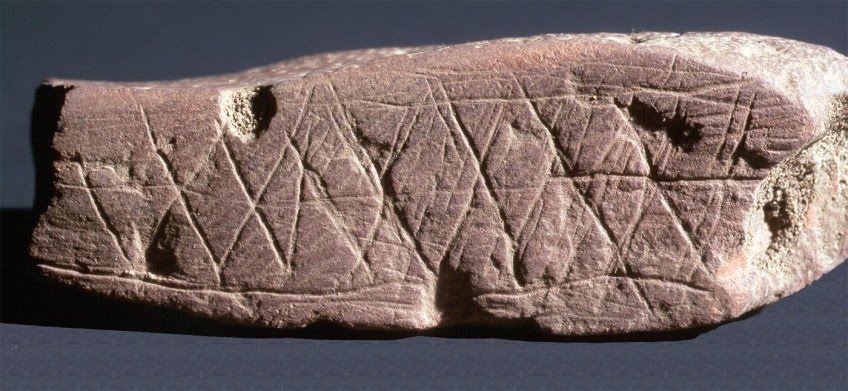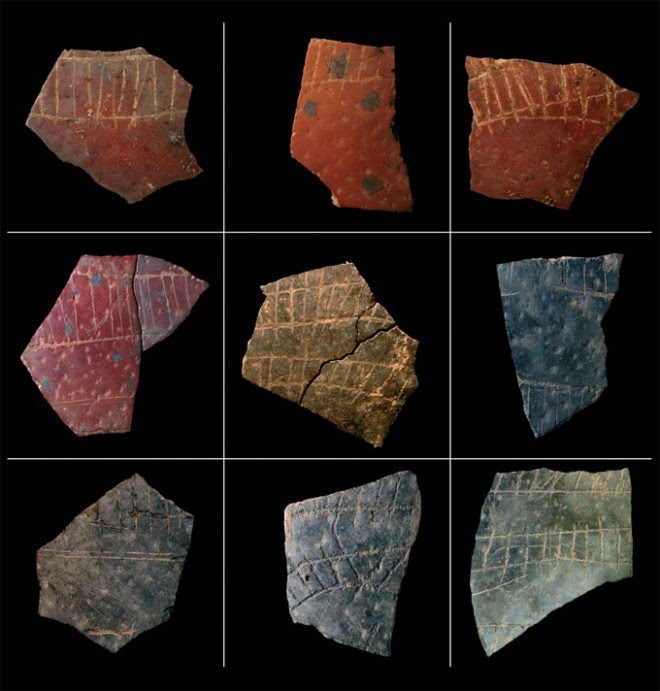An interesting historical aspect concerning tiling is establishing the oldest extant artefact consisting of a tiling. And indeed other more recent, in relative terms, historical instances for general interest. As such, this aspect is poorly documented, with much vagueness, with what is given or stated of some doubt, at least to me, as to if it can indeed be called or interpreted as a tiling. For instance, should a building of rectangular bricks, that thus naturally arises, be considered as a ‘purposeful’ tiling? It is debatable. The following is a chronological listing, with the earliest references first, that is considered, or stated to be, tiling artefacts of some description. My interest in this topic arose from seeing, quite fortuitously, a tiling of hexagons on a mammoth tusk, as below, in a book on Ice Age art at a local library. This set me thinking and searching for other early tilings, in the course of which I posted on the Google academic mathematical tiling group (August 2019), which led to other references from correspondents, specifically of the Blombos Cave and ostrich shell fragments, albeit not to me entirely convincing. Indeed, I have to say, I do not consider these as tilings per se. However, I include here for the sake of possibility and further debate. Comments are welcome. Although not to excuse poor writing/research, the following can be considered as a first attempt, albeit of a largely considered, but not exhaustive enquiry. References here are not always ideal in many ways and is as my wont, rather than a concentrated single focus study, of many days and weeks, if not months required to satisfactorily detail all aspects (or as much as is practical), I will return to the subject in my normal more ‘relaxed’ manner at ad hoc intervals and duly update and revise. The Listings C. 77,000 years ‘Geometrically engraved piece of ochre block from the Blombos Cave, South Africa’. Ancient 'paint factory' unearthed, Blombos Cave Geometrically engraved piece of ochre block. Christoper S. Henshilwood Creative Commons Legal CodeFrom the pictures, I am very far from convinced! All we have here is a series of lines loosely described as rhombuses. Encyclopedia Britannica states ‘A crosshatch design’. Is a tiling intended? A prevalent theme here from the BBC report is of conceptual thought or symbolism. Significantly, tiling (or tessellation) is not discussed or even implied. A tiling? Not to me in the normal sense of the term. 60,000 years Inscribed ostrich shell fragments found in South Africa Ostrich Shell Fragments found in South AfricaFrom the pictures, I am far from convinced! All we have here is a series of lines at various angles. Is a tiling intended? A prevalent theme here of the accompanying text is of conceptual thought or symbolism. Significantly, tiling (or tessellation) is not discussed or even implied. A tiling? Not to me in the normal sense of the term. '12,000-15,000 BC' ‘Mammoth tusk with an engraving of (many) irregular hexagons and is dated ‘12,000-15,000 BC’ and ‘about 21,000’. (The authorities differ in their dating.) Mammoth Tusk, Eliseevichi, Russia A mammoth tusk, described as a ‘fish’, with hexagonal scales. The artefact was found in Eliseevichi, Russia (midway between Moscow and Kiev), and was excavated in 1935. Whether the artist intended a broad regular hexagon is unclear, bearing in mind the limitations of the tools of the day and curved surface. The tusk is in the collection of the Peter the Great Museum of Anthropology and Ethnography, Russia, of which I investigated their website, with a Google translation of the text, below. The tusk is described as a fish in the museum catalogue (with the tiling as scales), although save for the body I can see very little fish resemblance: A plane stylized image of a fish, for the manufacture of which a longitudinal cleavage was used from the outer surface of a mammoth tusk. Its shape resembles the shape of the body of a freshwater fish, and in a small extension at the narrow end, a caudal fin is guessed. A series of eleven longitudinal, slightly diverging to the sides from the center to the edges of the furrows indicate the rays of the caudal fin. Right the part is covered with a honeycomb ornament that imitates fish scales, the left - zigzag ornament. To the best of my knowledge, this has not been discussed in the mathematical literature as a tiling, but rather before in different contexts, as art (and curiously) medically, but they do not seem to have recognised the historical significance of the tiling and indeed mathematical aspect. This is surely one of the oldest mathematical artefacts per se, on a broad par with the Ishango Bone, between 18,000 BC and 20,000 BC! Or am I missing something? 13th century BC Elamite Temple at Chogha Zanbil (Wikipedia, Tile) One of the earliest uses of tiles can be found in the Elamite Temple at Chogha Zanbil, which dates from the 13th century BC. Elamite Temple at Chogha Zanbil4000 BC (Wikipedia) A temple mosaic from the ancient Sumerian city of Uruk IV (3400–3100 BC), showing a tessellation pattern in coloured tiles 575 BC Ishtar Gate of Babylon, from about 575 BC. (unique tiles, not sourced) 3 BC Semi-regular tilings discovered by the Greek mathematician Archimedes (c 290/280 - 212/211 B.C), described in his writings, later named in honour of him. References Blombos Cave https://www.bbc.com/news/science-environment-15257259 (Ancient 'paint factory' unearthed) Etched Ostrich Eggs http://news.bbc.co.uk/2/hi/science/nature/8544332.stm https://www.sciencemag.org/news/2010/03/engraved-eggs-suggest-early-symbolism Mammoth Tusk http://citeseerx.ist.psu.edu/viewdoc/download?doi=10.1.1.908.9708&rep=rep1&type=pdf Cook, Jill. Ice Age art: arrival of the modern mind. British Museum Press 2013, pp. 108-109, 134 MAA: Mathematical Treasure: Ishango Bone: https://www.maa.org/press/periodicals/convergence/mathematical-treasure-ishango-bone ‘... approximately 20,000-25,000 years ago’. Peter the Great Museum of Anthropology and Ethnography (the Kunstkamera): http://lib.kunstkamera.ru/files/lib/978-5-88431-302-6/978-5-88431-302-6_08.pdf See pp. 255-257, near the end of the document Google translation, with my own clarifications in brackets): 54. 1 A FISH. MAE No. 5298–2850 (catalogue reference) Mammoth tusk Length 19.2 cm, width 4.6 cm, thickness 1.1 cm Eliseevichi 1, Bryansk region, Zhiryatinsky district Epigravett, 15-12 thousand liters. N (12-15 thousand years) Excavations of K. M. Polikarpovich, 1935 A plane stylized image of a fish, for the manufacture of which a longitudinal cleavage was used from the outer surface of a mammoth tusk. Its shape resembles the shape of the body of a freshwater fish, and in a small extension at the narrow end, a caudal fin is guessed. A series of eleven longitudinal, slightly diverging to the sides from the center to the edges of the furrows indicate the rays of the caudal fin. Right the part is covered with a honeycomb ornament that imitates fish scales, the left - zigzag ornament. Dedicated entry: http://collection.kunstkamera.ru/entity/OBJECT/271906?query=5298-2850&index=0 Schott G. D. ‘Engraved hexagons on an Ice Age ivory: a neurological perspective on an anthropological debate’. Journal Neurology Neurosurgery and Psychiatry. 2014 October; 85 Issue 10: pp. 1174-6. https://jnnp.bmj.com/content/85/10/1174 The link gives the first page of the article, behind a paywall. I have not seen the article. Elamite Temple at Chogha Zanbil https://en.wikipedia.org/wiki/Tile Elamite Temple at Chogha Zanbil Sumerians Wikipedia https://en.wikipedia.org/wiki/Tessellation Tessellations were used by the Sumerians (about 4000 BC) in building wall decorations formed by patterns of clay tiles. Created 20 December 2019 |



